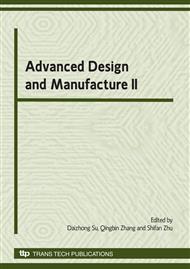p.313
p.317
p.321
p.325
p.329
p.333
p.337
p.341
p.345
Design for Saving Energy Based on Energy Flow Analysis Method and CAE Technology
Abstract:
This paper presents the design method of electromechanical products for saving energy based on energy flow analysis. The energy transfer model and energy correlation model are built through analyzing the relation of energy flow and products performance in order to address the conflict between energy saving and performance optimization. Based on the energy transfer model, the performance pertinences and performance margins of electromechanical products are analyzed with CAE technology and value engineering theory. Finally, the split air-conditioner’s outdoor unit is studied and the design method for saving energy based on energy flow analysis is adopted to solve the conflict between air flow increasing and noise reduction.
Info:
Periodical:
Pages:
329-332
Citation:
Online since:
October 2009
Authors:
Permissions:
Share:
Citation:


